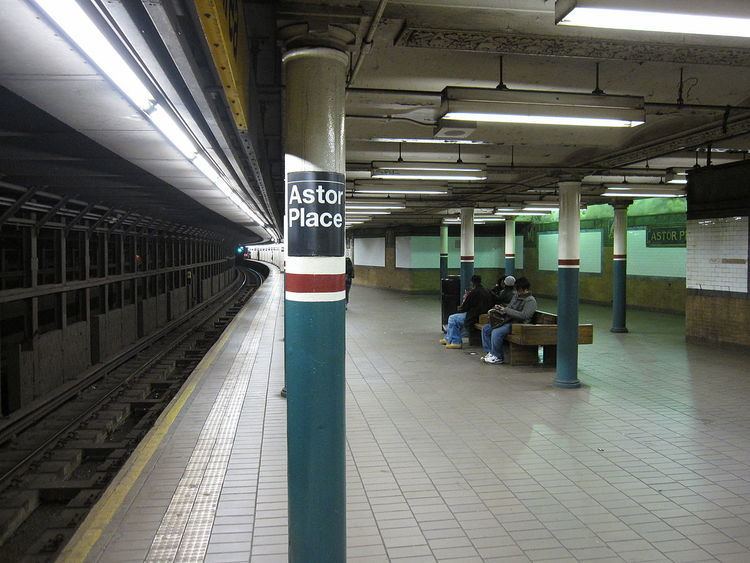Locale NoHo / East Village Structure Underground Opened 27 October 1904 Tracks 4 | Division A (IRT) Borough Manhattan Added to NRHP 17 September 2004 | |
 | ||
Line IRT Lexington Avenue Line Services 4 (late nights)
6 (all times) <6> (weekdays until 8:45 p.m., peak direction) Transit connections NYCT Bus: M1, M2, M3, M8 Address New York, NY 10003, United States Similar Spring Street, 23rd Street, 33rd Street, 28th Street, 110th Street | ||
Astor Place, also called Astor Place – Cooper Union on signs, is a local station on the IRT Lexington Avenue Line of the New York City Subway. Completed in 1904, it is one of the original twenty-eight stations in the system. Located at the intersection of Lafayette Street, Eighth Street, Fourth Avenue, Cooper Square, and Astor Place between the East Village and NoHo, it is served by the 6 train at all times, the <6> train during weekday in peak direction and by the 4 train during late nights. The station is on the List of Registered Historic Places in New York.
Contents
History
Construction started on the first IRT line in 1900. The part of the line from City Hall to just south of 42nd Street was part of the original IRT line including the Astor Place station, opened on October 27, 1904.
In 1981, the MTA listed the station among the 69 most deteriorated stations in the subway system. The station underwent renovation from June 1984 to May 1986. The station was renovated for $2,500,000, and was part of the Adopt-a-station program. The money included $600,000 from the Federal Urban Mass Transit Administration, $125,000 from private sources, including some from the Vincent Astor Foundation. The scope of the project included the restoration of the famous glazed ceramic beaver plaques, new improved lighting, the installation of noise-abatement material, as well as the installation of new brown floor tiles. A new piece of porcelain steel artwork by Cooper Union alumnus Milton Glaser was installed, and a cast-iron copy of one of the station's original kiosks was built. There was an underpass between the uptown and downtown sides, but it was closed and covered up in the 1980s renovation.
The original plans for the Hudson and Manhattan Railroad (now PATH) included a spur along Ninth Street to this station.
Station layout
Astor Place is a local station with four tracks and two side platforms. The fare control is at platform level, and the underpass connecting northbound and southbound sides was removed in the 1980s. The access hatch to the underpass is visible behind the northbound token booth inside the fare control area. The northbound platform contains a news and candy stand, which replaced the original public women's lavatory. On the southbound side, the station has a department store entrance into a K-Mart. This store was originally constructed in 1868 as an A. T. Stewart. It had changed ownership and was a Wanamaker's when the station was constructed. The heavy brick-faced square columns on the downtown platform support the store above. The northern building of Wanamaker's store, but not the southern building above, burned in the 1950s. Octagonal windows on the brick wall of the platform were the store's showcases.
Plaques of beavers are located on the walls, in honor of John Jacob Astor's fortune derived from the beaver-pelt trade. The plaques, as well as name tablets, were made by the Grueby Faience Company in 1904. During the renovation, the magnificent maroon and gold tile Cooper Union signs underneath the tile Astor Place signs were destroyed. Black and white pillar signs read Astor Place on one pillar, then Cooper Union on the next.
Exits
The station has two entrances, one in each direction. The southbound platform's entrance is at the southwest corner of Astor Place and Lafayette Street, while the northbound platform's entrance is in the traffic island bounded by Fourth Avenue, Lafayette Street, and Eighth Street. There is a reproduction of an IRT entry kiosk on the street level over the northbound entrance.
Points of interest
The station itself is a point of local interest, as it is on the List of Registered Historic Places in New York. Several other sites of historical and cultural importance located near the station. The New York University and Cooper Union are both located nearby. Visitors to the Astor Place area often rotate the Alamo Cube, at street level above the tail end of the northbound platform. A tiled-up doorway, on southwest wall behind the southbound token booth, sports a lintel proclaiming "Clinton Hall". This doorway once led to the New York Mercantile Library in the former Astor Opera House. Other points of interest include:
The Eighth Street – New York University station on the BMT Broadway Line is one block west of the station.
